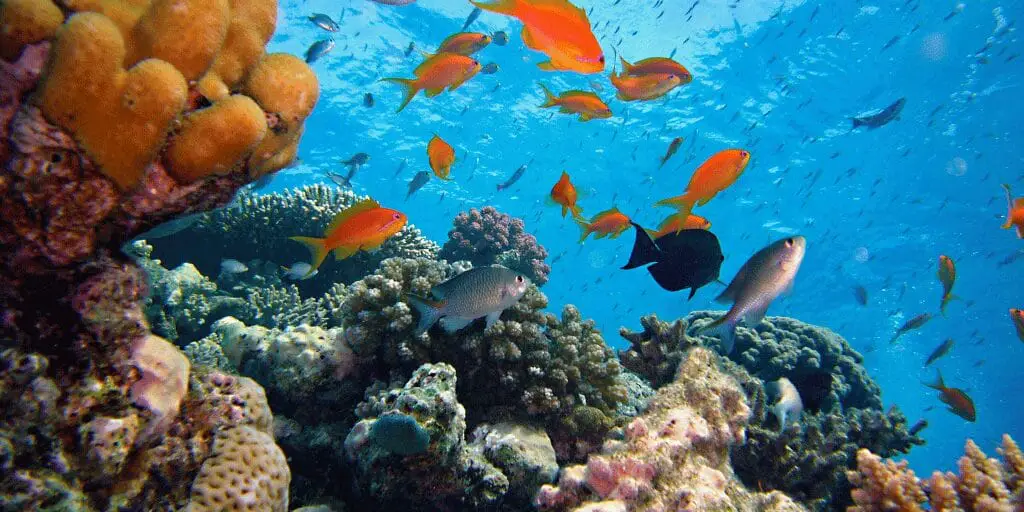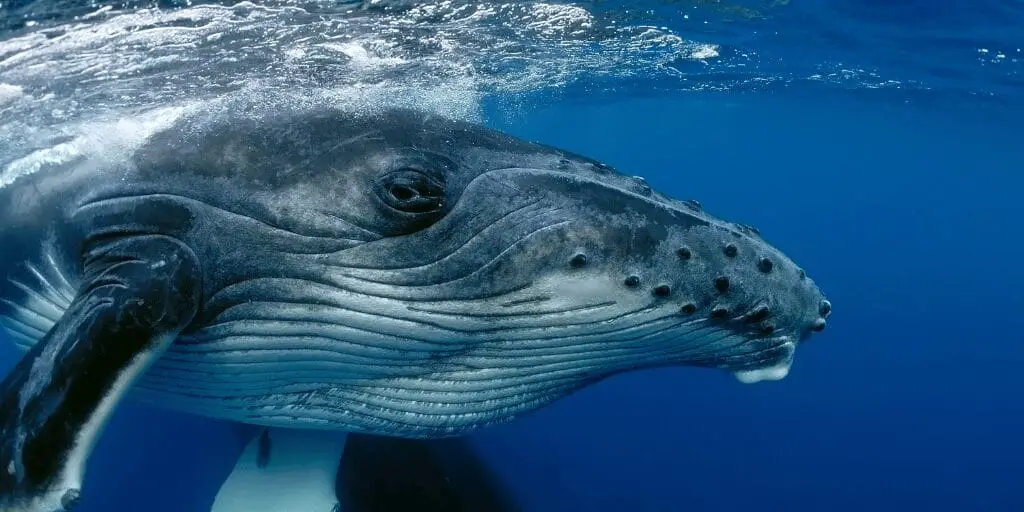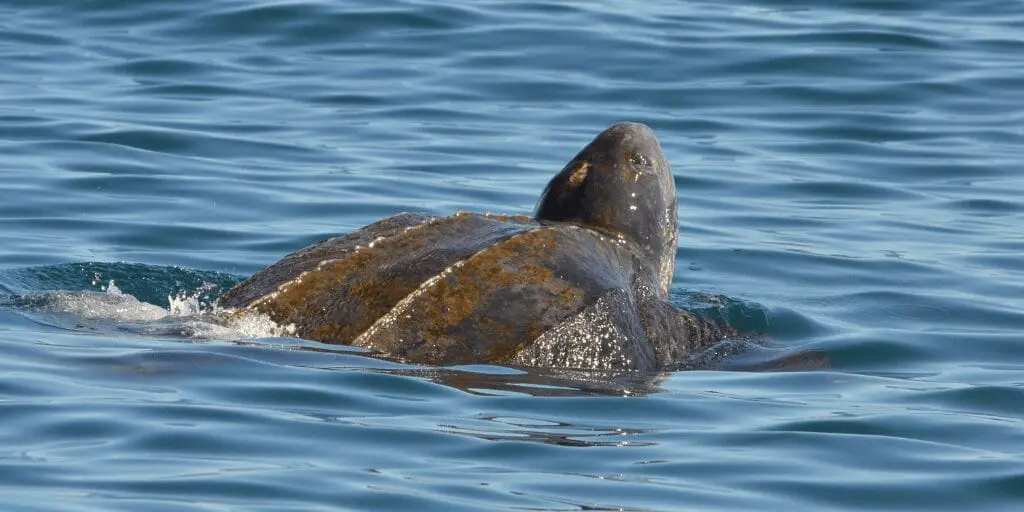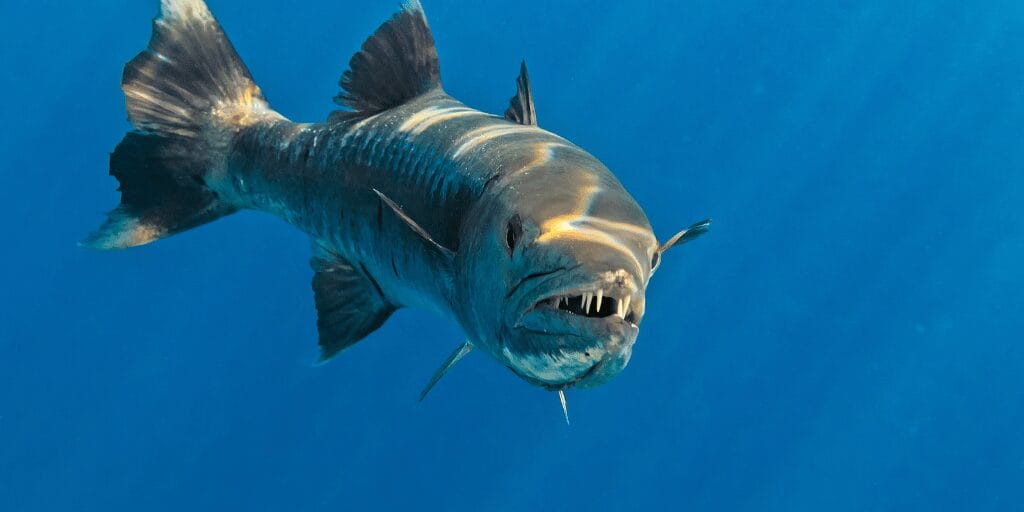The oceans of our world are like another planet, full of strange and amazing creatures. From colorful fish in warm waters to mysterious animals living in the darkest depths, there’s so much to discover.
But wait, not every ocean creature is friendly! Some have sharp teeth, painful stings, or hidden defenses we need to be aware of.
Let’s take a walk around the world’s oceans together. We’ll see enormous whales, learn about famous sharks, and meet the weirdest fish you can imagine. We’ll also discover which creatures to watch out for, so we can stay safe while exploring this underwater world.
How Does the World of Ocean Creatures Grow?

Ocean creatures grow through a complex process driven by food, genetics, and their environment. Tiny creatures like plankton form the base of the food chain. Sunlight fuels their growth, which then supports larger animals higher up the food chain.
Each creature’s genes determine its size, shape, and how it adapts to its environment. For example, cold-water animals often grow bigger than those in warm waters.
- The Food Factor: The ocean’s food chain is like a pyramid. Microscopic plankton are the foundation, using sunlight for energy. Small fish eat the plankton, bigger fish eat the smaller fish, and so on.
- It’s in Their Genes: Every living thing has DNA, like an instruction manual that dictates how it will grow. A sea turtle’s DNA tells it to have a shell. A whale’s DNA makes it the largest animal on Earth. Genes determine how fast a creature grows, its lifespan, and how it functions.
- Environmental Influence: Cold water slows down fish metabolism, giving them time to grow larger. Some creatures adapt to extreme environments like those near deep-sea vents. The chemicals and heat influence the type of life that thrives there.
The Wonders of Saltwater Life
Our planet’s oceans hold a breathtaking secret: the overwhelming majority of Earth’s animals call these salty waters home. To learn more about this incredible diversity, visit our guide to saltwater creatures.
From the gentle giants of the deep to the dazzling fish darting through vibrant coral reefs, saltwater life never ceases to amaze. Imagine snorkeling alongside a magnificent manta ray, witnessing the power of a breaching whale, or marveling at the otherworldly forms of bioluminescent creatures in the midnight zone.
Beyond these iconic examples, there’s an entire universe to discover. Curious creatures that hide themselves among rocks, eels with electrifying defenses, and fish that change colors or can even walk on land – the ocean is bursting with wonders that challenge our imaginations.
Saltwater environments enable remarkable adaptations and a dazzling kaleidoscope of life. Let’s explore a few more fascinating facets of this underwater world.
- Masters of Disguise: Animals like octopuses and cuttlefish possess remarkable camouflage abilities, changing color and texture in seconds to blend seamlessly with their surroundings.
- Survival Skills: Saltwater creatures employ astonishing survival tactics. Pufferfish inflate into spiky balloons, sharks possess electroreception to sense prey, and some fish migrate thousands of miles to spawn.
- Coral Reef Ecosystems: These vibrant underwater cities teem with life, showcasing complex relationships between fish, invertebrates, and even the coral itself.
Ocean Giants: Exploring the Largest Creatures

The size of the ocean allows for creatures of truly awe-inspiring sizes. As we dive deeper, these giants of the sea reveal themselves; some graceful, some mysterious, but all incredibly massive.
Among these giants, whales reign supreme. Humpback whales, with their acrobatic leaps and haunting songs, fill the water with wonder.
Sperm whales plunge vast depths in search of giant squid. And then there’s the undisputed king of ocean size – the blue whale. As the largest animal that has ever lived on Earth, this magnificent creature can stretch the length of three school buses!
But our ocean giants aren’t limited to whales. Consider the massive whale shark, the largest fish in the sea, a gentle giant that filters food through its enormous mouth. Or the graceful giants known as manta rays, soaring through the water with wing-like fins spanning impressive lengths.
Beyond size, these ocean giants boast remarkable adaptations:
- Whale Songs: Complex whale vocalizations serve for communication, navigation, and even hunting.
- Filter Feeding: Baleen whales and enormous sharks strain ocean water for huge quantities of tiny prey.
- Deep Diving: Sperm whales hold the record for deepest dives, adapting to crushing pressure to hunt their favorite food.
Exploring the lifestyles of these enormous creatures sheds light on the ocean’s vast food web and reminds us of the immense power and wonder that thrives beneath the waves.
Exploring the World’s Oceans
Our planet’s interconnected oceans cover over 70% of its surface, creating a dynamic world with distinct regions. From calm, sun-drenched waters to the icy extremes of the poles, each ocean tells a different story.
Let’s dive in and explore their unique characteristics, the captivating life within, and the vital role the oceans play for our entire planet.
The Atlantic Ocean

The Atlantic Ocean, the second-largest ocean on Earth, stretches from the icy Arctic to the shores of Antarctica. It’s known for its strong currents, like the Gulf Stream, which significantly influence weather patterns on surrounding continents.
The Atlantic also possesses remarkable underwater features, including the vast Mid-Atlantic Ridge and deep ocean trenches.
This vibrant ocean teems with a diverse array of creatures:
- Leatherback Sea Turtle: These colossal turtles cross the entire Atlantic during their incredible migrations.
- Sea Lions: Playful and agile, several sea lion species make the Atlantic their home.
- Atlantic Wolffish: This unique-looking fish lurks in the ocean’s depths.
- Humpback Whale: Their iconic songs and acrobatic breaches fill the Atlantic waters.
These are just a glimpse into the Atlantic’s wild residents. Discover even more captivating creatures that navigate the waters of this dynamic ocean here.
The Pacific Ocean
The Pacific Ocean reigns as the largest and deepest of Earth’s oceans, stretching across a vast expanse from the Arctic to Antarctica. Its sheer size makes it a world of extremes. Home to the planet’s deepest point, the Mariana Trench, it also houses vibrant coral reefs teeming with life near the sunlit surface.
The Pacific’s enormous size gives rise to unparalleled biodiversity, home to creatures both remarkable and fascinating:
- Giant Pacific Octopus: Masters of camouflage and renowned for their intelligence, these cephalopods navigate the Pacific’s depths, solving puzzles and outwitting predators.
- Humpback Whale: Their breathtaking breaches and haunting songs echo across the vast Pacific, used for communication and finding mates.
- Dugong: Known as “sea cows”, these gentle mammals graze on the Pacific’s seagrass meadows, playing a vital role in their ecosystem.
- Manta Ray: These graceful giants filter tiny plankton as they glide through the water, their wing-like fins spanning incredible lengths.
These are but a small selection of the astounding life thriving within the Pacific. Learn more about their adaptations and the challenges they face in our detailed article.
The Indian Ocean

Known for its warm waters and unique currents, the Indian Ocean hosts a fascinating array of marine life. This tropical and subtropical ocean stretches from Africa to Australia, supporting diverse ecosystems, from shallow coastal waters to deep ocean regions.
With influences from the monsoons and the absence of a connection to the frigid Arctic, the Indian Ocean maintains a comfortably warm temperature for incredible biodiversity.
Among its captivating residents, you’ll find:
- Great Barracuda: Sleek and silvery predators, barracudas slice through the waters with impressive speed, ambushing their prey with razor-sharp teeth.
- Mantis Shrimp: These vibrantly colored crustaceans possess incredibly powerful claws, unleashing strikes faster than bullets. Their eyes also hold amazing complexity, enabling them to view a wider spectrum of light than humans.
- Giant Squid: Elusive dwellers of the ocean depths, giant squid remains shrouded in mystery but can reach immense sizes, fueling legends of sea monsters.
- Giant Grouper: These massive fish can grow to enormous lengths and lurk in caves and shipwrecks along the ocean floor. Their size and power demand respect.
Beyond these highlights, the Indian Ocean teems with diverse life: spinner dolphins perform acrobatic leaps, whale sharks gracefully filter-feed, and vibrant coral reefs support a kaleidoscope of species.
These are just a few of the treasures waiting to be discovered within this unique ocean. To continue the exploration, dive into our detailed article here.
The Southern Ocean
Also known as the Antarctic Ocean, the Southern Ocean surrounds the icy continent of Antarctica. It’s a world of extremes, distinguished by its cold temperatures, powerful currents, and unique creatures superbly adapted to life in these harsh conditions.
This cold ocean is home to some of Earth’s most resilient creatures, showcasing unique ways to survive in the cold:
- Adelie Penguin: With their classic tuxedo markings, Adelie penguins thrive in the Southern Ocean’s harsh environment, forming massive colonies. They face icy winds and sub-zero temperatures to raise their young.
- Albatross: These stunning seabirds possess enormous wingspans, effortlessly gliding over the Southern Ocean’s vast distances. Their specialized physiology allows them to soar for hours without flapping.
- Killer Whale (Orca): Apex predators of the ocean, killer whales roam Southern Ocean waters in intelligent pods, employing sophisticated hunting strategies.
- Seals: Several seal species call this ocean home. Leopard seals, with their powerful builds and spotted coats, are formidable hunters, while Weddell seals can dive incredibly deep under the ice.
- Sponges: Surprisingly, vibrant sponges dot the seafloor, filtering food from the nutrient-rich waters. They even offer habitat for smaller creatures.
The Southern Ocean also hosts massive squid, and enormous whale species, and plays a crucial role in the global food chain.
Krill, tiny shrimp-like crustaceans, form the base of this ecosystem, feeding penguins, whales, and countless other creatures. Discover more about these fascinating creatures and the icy environment they thrive in here.
The Arctic Ocean

Located around the North Pole, the Arctic Ocean is Earth’s smallest and shallowest ocean. It’s characterized by frigid waters, sea ice that expands and shrinks with the seasons, and a diverse collection of wildlife uniquely adapted to survive these harsh conditions.
The Arctic may seem desolate, but life finds incredible ways to thrive here:
- Narwhal: These “unicorns of the sea” have a long spiraling tusk protruding from their heads. They navigate icy waters in pods, using echolocation to locate prey.
- Beluga Whale: Gleaming white and incredibly social, beluga whales are often called the “canaries of the sea” for their wide range of vocalizations used for communication.
- Polar Bear: As the icons of the Arctic, polar bears are built for life on the ice. Their heavy fur, powerful paws for hunting seals, and keen sense of smell make them superbly adapted predators.
- Walrus: With their massive tusks and bulky bodies, these creatures haul themselves out on ice floes to rest and socialize. Their whiskers even help them locate food on the seafloor!
Beyond these icons, the Arctic harbors Arctic foxes with color-changing fur, harp seals known for their beautiful pups, and countless seabirds nesting on its shores.
This icy ocean also supports the base of the Arctic food web: masses of tiny plankton fueling the entire ecosystem. Discover more amazing adaptations and facts within our in-depth article.
The Ocean’s Dangers: Creatures to Respect
While the ocean is filled with incredible beauty and wonder, it’s essential to remember that some creatures pose potential risks to humans.
From powerful predators to those with venomous stings or bites, a few animals demand a healthy dose of caution. Understanding these dangers and exercising respect allows for a more informed and safer ocean experience.
Here’s why awareness matters:
- Sharks: Certain shark species, mistaking humans for prey, cause rare but serious bites.
- Jellyfish: Some jellyfish possess surprisingly powerful stings, causing pain or even severe reactions.
- Stonefish: Masters of camouflage, their venomous spines can inflict an extremely painful sting.
- Cone Snails: These beautiful snails pack a surprisingly dangerous venomous harpoon for hunting.
Safety Tips:
- Learn Before You Go: Research the area and any potential hazards before swimming, diving, or exploring tide pools. To learn more about the ocean’s most formidable inhabitants, check out our guide on the deadliest ocean animals.
- Respect Wildlife: Don’t touch, chase, or harass marine creatures. Observe from a safe distance and allow them their space.
- Heed Warnings: Pay attention to beach flags, posted signage, and advice from lifeguards or local authorities. These warnings exist for your safety.
- Shuffle Your Feet: When walking in shallow water, shuffle your feet to avoid stepping on hidden sea creatures or other bottom-dwelling creatures.
- Swim with a Buddy: Never swim alone. Having a partner increases safety and allows for help in case of an emergency.
- Know First Aid: Learn basic first aid for jellyfish stings, cuts, and other minor marine-related injuries. Consider carrying a simple first aid kit.
- Seek Professional Help: If you experience a severe reaction or an animal bite, seek professional medical attention immediately.
If you’re interested in learning about other potentially dangerous creatures, explore our list of common dangerous ocean animals. Remember, with knowledge and respect, the ocean can be enjoyed safely, allowing its wonders to unfold before us.
A Last Word on Ocean Animals from Globe
Ocean exploration has introduced us to a vast variety of marine life, from the microscopic plankton that forms the base of the food chain to the majestic whales that dominate the open seas.
We’ve explored different ocean environments, each with its unique inhabitants and challenges. Along the way, we’ve learned about the remarkable adaptations that allow these creatures to thrive in their saltwater homes.
However, it’s also important to approach the ocean with respect for its potential dangers. By understanding the risks posed by certain marine animals and following safety guidelines, we can enjoy the beauty of the ocean while minimizing harm to ourselves and the ecosystems we visit.
The ocean’s vastness and diversity hold endless opportunities for discovery, emphasizing the need for conservation and careful exploration.

